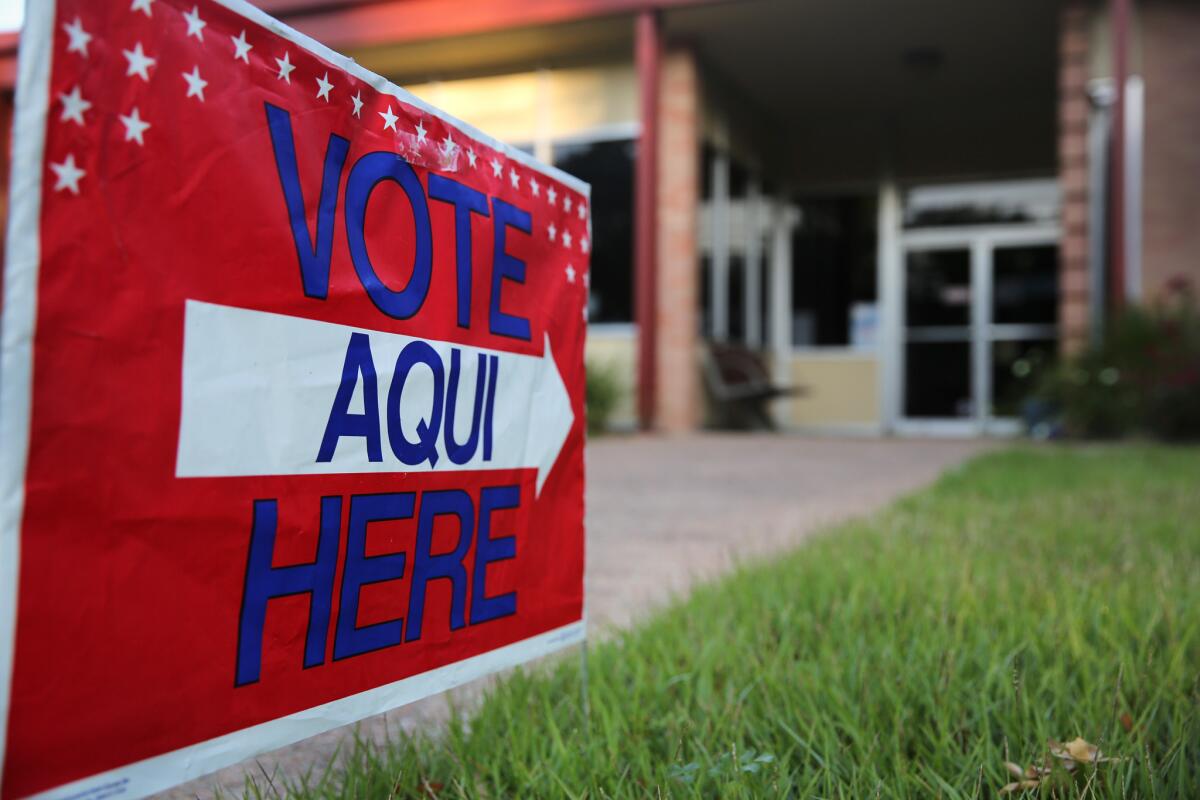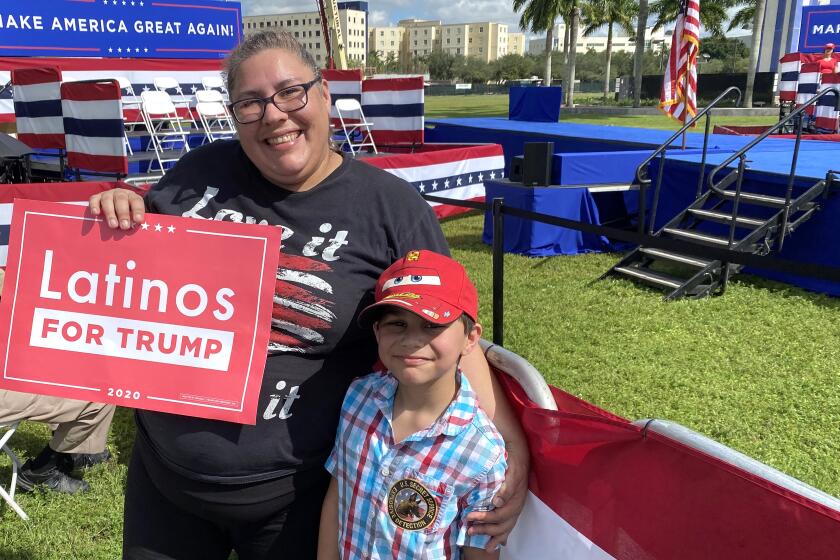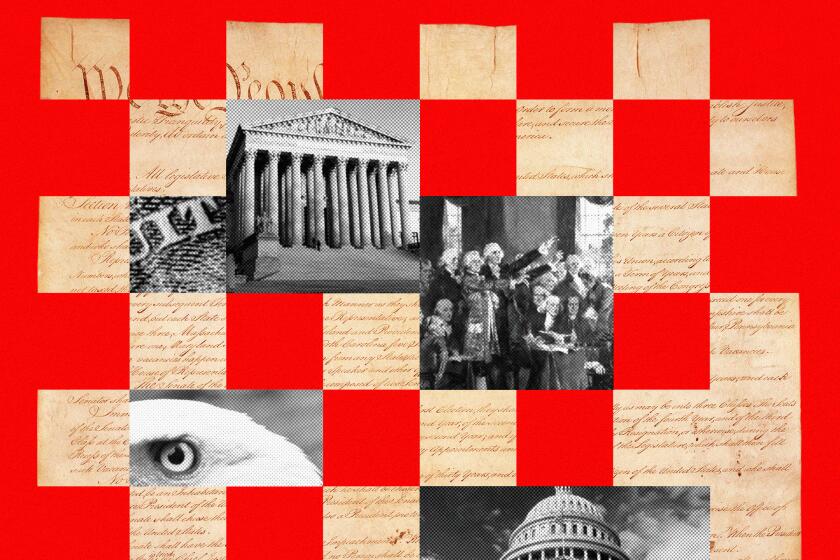Op-Ed: The relationship between Latinos and ‘Latinx’? It’s complicated

When asked how Democrats might translate their success among Arizona’s Latinx community in the latest presidential election, U.S. Rep. Ruben Gallego (D-Ariz.) tweeted a sharp reply: “First start by not using the term Latinx.”
Though presented as a personal objection, the representative’s remarks have broader significance. The insertion of “Latinx” into the election’s postmortem ritual is the latest iteration of a decades-long battle over names, one that raises questions at the heart of the very idea of a nationwide “Latino vote”: Who belongs to this political community, what are “Latino issues,” and who should be Latinos’ allies?
“Latinx” is of recent vintage, emerging from academia in the 2000s and gaining mainstream usage after the mass shootings at Pulse nightclub in Orlando, Fla.; many of those killed were Latinx. It signals inclusion of individuals who do not identify as male or female, who don’t see gender as binary, inscribed in a Spanish language of gendered nouns (such as Latino/Latina). It has particularly resonated with younger people and those in the LGBTQ community.
Critics on the left and right took note during the Democratic primaries when Massachusetts Sen. Elizabeth Warren’s campaign adopted “Latinx” for its Latino outreach. Its use reinforced Warren’s progressive credentials, but detractors cited polls showing that the term is not widely embraced by the constituency it claims to represent.
An August Pew Research Center poll found that only 3% of Latino adults use the label “Latinx,” though almost 15% of Hispanic women ages 18 to 29 do. Many of those who avoid it consider “Latinx” an elitist and outsider identifier. As Gallego put it postelection, the use of “Latinx” symbolizes an attempt to take “away some of my culture” and reorient it toward someone else’s “perspective.” The implication is that politicians who use “Latinx” are yielding to external sensibilities rather than respecting the preferences of their constituencies. Candidates who speak of “Latinx” voters could damage their standing with the country’s largest minority group, according to some political analysts.
Can we finally put to rest the idea that Latinos are politically aligned — rather than a vast and diverse group of people with different interests, experiences and, yes, political leanings?
The search for a name that is inclusive enough to capture Latinos’ tremendous diversity — across national origin, language, skin color, region, religion, sexuality and gender identity — has long been at the center of the group’s struggle to wield power in this country.
Since a nationwide “Latino vote” first appeared, nomenclature has been a crucial point of debate. After helping John F. Kennedy win the presidency in 1960, Mexican Americans tried to convert their “Viva Kennedy” clubs into a permanent alliance spanning the Southwest. Yet at a 1961 meeting in Phoenix, they could not advance beyond the question of what to call themselves. Having adopted terms reflecting their distinct communities, self-described “Mexican Americans” from California clashed with a contingent of Texas’ “Latin Americans,” while others insisted upon the term “Spanish-speaking.” Some rejected ethnic labels altogether, preferring to emphasize their Americanism.
Like “Latinx,” these labels were seen as both cultural and political identifiers. For example, to call oneself “Mexican American” was, in the early 1960s, to assert ancestral pride against a racist society, similar to African Americans’ embrace of the term “Black” and rejection of “Negro.”
“Mexican American” was widely accepted by leaders in the community by the mid-1960s. Yet the younger generation soon began calling themselves “Chicanos,” a term that stressed their Mexican and Indigenous roots and indicated solidarity with workers, immigrants and the poor. Many of their elders strenuously disapproved.
As Puerto Ricans and Cubans entered the political arena in greater numbers, some demanded inclusion alongside Mexican Americans in political parties and government programs. By the late 1960s, U.S. Rep. Edward Roybal, a Los Angeles Democrat and Mexican American, saw an opportunity to unite them in an electorate that would stretch from coast to coast. But first they needed an overarching name.
In Washington, Roybal helped propose terms the government could use to try to bring these constituencies under the same umbrella. They included “Spanish-speaking,” “Spanish American,” “Spanish-surnamed” and “Hispanic.” Some labels met strong resistance for alleged inauthenticity. Like “Latinx” today, “Hispanic” was controversial. Some Mexican American political leaders feared that “Hispanic” would obscure the specific problems of Mexican Americans by lumping their communities in with those they had little in common with.
Yet “Hispanic” became widely accepted after it was adopted by the media, used in political discourse and stamped on countless government forms from the late 1970s on.
Those presently objecting to the use of “Latinx” should consider that the meanings and use of such labels in the political arena have changed considerably over time. In 1964, Republicans formed a “Latinos con Goldwater” committee to support the conservative senator in his presidential campaign. Yet by the 1970s, the term “Latino” had migrated leftward, with Democrats forming a “Latino Caucus” within their party in 1972. When the GOP created a “Republican National Hispanic Assembly” two years later, they had come to see “Hispanic” as the more conservative identifier. Within a few more years, there were the “Hispanic American Democrats.” In the latest presidential elections, Latinos for Trump posters were omnipresent in Cuban parts of Miami.
Given this history of shifts, it can be expected that the use and meaning of “Latinx” will evolve, and along with it the discomfort that some have with the term.
There is another lesson to learn from Roybal, who was deeply mindful that labels mattered and thought that national identities would continue to be important to the communities he sought to unite. He was flexible. He knew that different times and situations called for different terms. At a time when many saw “Hispanic” and “Latino” as reflecting different political orientations, Roybal pushed for the acceptance of both. Constructing a pan-Latino political community was about coalition-building above all. Latinos did not have the luxury of ostracizing one another.
Despite its relative novelty, “Latinx” has taken its place in the long struggle over Latino identity in the United States. Instead of trying to eliminate its use — which was once attempted with the now-favored “Hispanic” — resisters should agree that one term could never encapsulate the vast array of ambitions and identities of the country’s largest minority group. Their diverse policies and political agendas should take center stage, however they define themselves.
Benjamin Francis-Fallon is the author of “The Rise of the Latino Vote: A History” and an associate professor of history at Western Carolina University.
More to Read
A cure for the common opinion
Get thought-provoking perspectives with our weekly newsletter.
You may occasionally receive promotional content from the Los Angeles Times.











